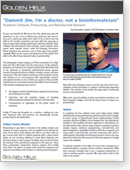"Dammit Jim, I'm a doctor, not a bioinformatician!"
Academic Software, Productivity, and Reproducible Research
By: Christophe Lambert, Chairman and CEO
Do you ever feel like Dr. McCoy on Star Trek, where your job and expertise is to do x, but to achieve your goals you also have to do y and z, which you either don't want to do or don't have the skills to do? Genetic researchers are faced with this every day as they are expected to design experiments, develop methods, write software that will perform these methods, teach students, write grants, work towards tenure, make life-changing discoveries, follow statistical best practices, and, in their spare time, publish regularly. What are the causes and symptoms of this reality? And what is the effect these demands have on productivity?
Hitchhiker's Guide to Next-Generation Sequencing
By: Gabe Rudy, Vice President of Product Development
If you have had any experience with Golden Helix, you know we are not a company to shy away from a challenge. So it's probably no surprise to you that the Golden Helix® R&D team has been keeping an eye on the developments of next-generation sequencing technologies. But what may have surprised you, as it certainly did us, was the speed in which these sequencing hardware platforms and services advanced. In a matter of a few short years, the price dropped and the accuracy improved to reach today's standards where acquiring whole exome or whole genome sequence data for samples is both affordable and accurate. This white paper covers the evolution of sequencing technologies as a research tool, the bioinformatics of getting raw sequence data into something you can use, and finally the challenges and unmet needs Golden Helix sees in the sense-making of that processed sequence data.
Is Free Software Really Free?
Examining the hidden costs of open-source bioinformatic software tools
When considering conducting genetic analysis, researchers often begin by looking at open-source tools or consider building a program themselves. In some instances, these are the only options available. While open-source tools are a vital and necessary component of any bioinformatics toolbox, many researchers never consider the hidden costs of open-source software when a proprietary option is available. In this whitepaper, the true cost of "free" software is explored, including time allocation, potential damage to one's reputation, and distraction from scientific discovery. Finally, five questions to consider in purchasing commercial software are discussed, as researchers weigh benefits and costs.


